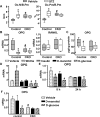Deletion of FoxO1, 3, and 4 in Osteoblast Progenitors Attenuates the Loss of Cancellous Bone Mass in a Mouse Model of Type 1 Diabetes
- PMID: 27491024
- PMCID: PMC5492385
- DOI: 10.1002/jbmr.2934
Deletion of FoxO1, 3, and 4 in Osteoblast Progenitors Attenuates the Loss of Cancellous Bone Mass in a Mouse Model of Type 1 Diabetes
Abstract
Type 1 diabetes is associated with osteopenia and increased fragility fractures, attributed to reduced bone formation. However, the molecular mechanisms mediating these effects remain unknown. Insulin promotes osteoblast formation and inhibits the activity of the FoxO transcription factors. FoxOs, on the other hand, inhibit osteoprogenitor proliferation and bone formation. Here, we investigated whether FoxOs play a role in the low bone mass associated with type 1 diabetes, using mice lacking FoxO1, 3, and 4 in osteoprogenitor cells (FoxO1,3,4ΔOsx1-Cre ). Streptozotocin-induced diabetes caused a reduction in bone mass and strength in FoxO-intact mice. In contrast, cancellous bone was unaffected in diabetic FoxO1,3,4ΔOsx1-Cre mice. The low bone mass in the FoxO-intact diabetic mice was associated with decreased osteoblast number and bone formation, as well as decreased expression of the anti-osteoclastogenic cytokine osteoprotegerin (OPG) and increased osteoclast number. FoxO deficiency did not alter the effects of diabetes on bone formation; however, it did prevent the decrease in OPG and the increase in osteoclast number. Addition of high glucose to osteoblastic cell cultures decreased OPG mRNA, indicating that hyperglycemia in and of itself contributes to diabetic bone loss. Taken together, these results suggest that FoxOs exacerbate the loss of cancellous bone mass associated with type 1 diabetes and that inactivation of FoxOs might ameliorate the adverse effects of insulin deficiency. © 2016 American Society for Bone and Mineral Research.
Keywords: BONE HISTOMORPHOMETRY; DISEASES AND DISORDERS OF/RELATED TO BONE; GENETIC ANIMAL MODELS; STROMAL/STEM CELLS; TRANSCRIPTION FACTORS.
© 2016 American Society for Bone and Mineral Research.
Conflict of interest statement
All authors state that they have no conflicts of interest.
Figures





Similar articles
-
CCAAT/enhancer binding protein β-deficiency enhances type 1 diabetic bone phenotype by increasing marrow adiposity and bone resorption.Am J Physiol Regul Integr Comp Physiol. 2011 May;300(5):R1250-60. doi: 10.1152/ajpregu.00764.2010. Epub 2011 Feb 23. Am J Physiol Regul Integr Comp Physiol. 2011. PMID: 21346244 Free PMC article.
-
Conditional Deletion of Sost in MSC-Derived Lineages Identifies Specific Cell-Type Contributions to Bone Mass and B-Cell Development.J Bone Miner Res. 2018 Oct;33(10):1748-1759. doi: 10.1002/jbmr.3467. Epub 2018 Jun 29. J Bone Miner Res. 2018. PMID: 29750826
-
Sirtuin1 (Sirt1) promotes cortical bone formation by preventing β-catenin sequestration by FoxO transcription factors in osteoblast progenitors.J Biol Chem. 2014 Aug 29;289(35):24069-78. doi: 10.1074/jbc.M114.561803. Epub 2014 Jul 7. J Biol Chem. 2014. PMID: 25002589 Free PMC article.
-
The Role of FoxOs in Bone Health and Disease.Curr Top Dev Biol. 2018;127:149-163. doi: 10.1016/bs.ctdb.2017.10.004. Epub 2017 Dec 14. Curr Top Dev Biol. 2018. PMID: 29433736 Review.
-
Unraveling the role of FoxOs in bone--insights from mouse models.Bone. 2011 Sep;49(3):319-27. doi: 10.1016/j.bone.2011.05.023. Epub 2011 Jun 1. Bone. 2011. PMID: 21664311 Free PMC article. Review.
Cited by
-
Revisiting Resveratrol as an Osteoprotective Agent: Molecular Evidence from In Vivo and In Vitro Studies.Biomedicines. 2023 May 16;11(5):1453. doi: 10.3390/biomedicines11051453. Biomedicines. 2023. PMID: 37239124 Free PMC article. Review.
-
Ethanol Inhibits Mesenchymal Stem Cell Osteochondral Lineage Differentiation Due in Part to an Activation of Forkhead Box Protein O-Specific Signaling.Alcohol Clin Exp Res. 2020 Jun;44(6):1204-1213. doi: 10.1111/acer.14337. Epub 2020 May 18. Alcohol Clin Exp Res. 2020. PMID: 32304578 Free PMC article.
-
Glycemic Control and Bone in Diabetes.Curr Osteoporos Rep. 2022 Dec;20(6):379-388. doi: 10.1007/s11914-022-00747-6. Epub 2022 Oct 10. Curr Osteoporos Rep. 2022. PMID: 36214991 Free PMC article. Review.
-
MiR-490-3p inhibits osteogenic differentiation in thoracic ligamentum flavum cells by targeting FOXO1.Int J Biol Sci. 2018 Aug 6;14(11):1457-1465. doi: 10.7150/ijbs.26686. eCollection 2018. Int J Biol Sci. 2018. PMID: 30262997 Free PMC article.
-
Diabetes impairs fracture healing through Foxo1 mediated disruption of ciliogenesis.Cell Death Discov. 2023 Aug 17;9(1):299. doi: 10.1038/s41420-023-01562-3. Cell Death Discov. 2023. PMID: 37591875 Free PMC article.
References
-
- Compston JE, Smith EM, Matthews C, Schofield P. Whole body composition and regional bone mass in women with insulin-dependent diabetes mellitus. Clin Endocrinol (Oxf) 1994;41(3):289–93. - PubMed
-
- Vestergaard P. Discrepancies in bone mineral density and fracture risk in patients with type 1 and type 2 diabetes—a meta-analysis. Osteoporos Int. 2007;18(4):427–44. - PubMed
-
- Hamann C, Kirschner S, Gunther KP, Hofbauer LC. Bone, sweet bone—osteoporotic fractures in diabetes mellitus. Nat Rev Endocrinol. 2012;8(5):297–305. - PubMed
-
- Hui SL, Epstein S, Johnston CC., Jr A prospective study of bone mass in patients with type I diabetes. J Clin Endocrinol Metab. 1985;60(1):74–80. - PubMed
Publication types
MeSH terms
Substances
Grants and funding
LinkOut - more resources
Full Text Sources
Other Literature Sources
Medical
Molecular Biology Databases
Research Materials
Miscellaneous

